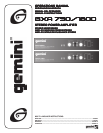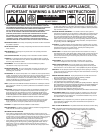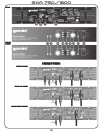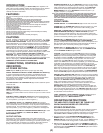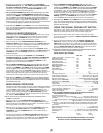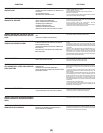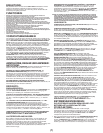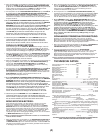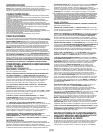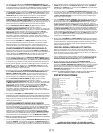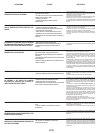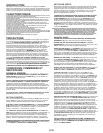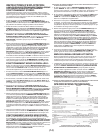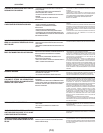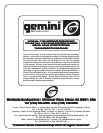(4)
INTRODUCTION:
Congratulations on purchasing your Gemini GXA power amplifier. This
state of the art power amplifier includes the latest features and is backed
by a three year limited warranty. Prior to use, we suggest that you
carefully read all the instructions.
FEATURES:
• State of the art technology provides exceptional reliability when working with difficult
speakers.
• Stable down to 2 ohm impedence
• Excellent handling of low frequencies as well as clear mids and flawless highs
• High output power to drive professional loudspeakers without distortion
• Oversized toroidal transformer, filter and heatsinks for better low end, transparency and stability
• Comprehensive protection circuitry (short, overheat, DC, subsonic and RF filters, turn-on
delay) with high current speaker protection relays
• Three modes of operation - stereo, parallel mono and mono bridge with mode status
indication LED on front panel
• Flexible input configuration with active balanced inputs; additional input
connectors to chain amps
• True clip LED for better control
• Front-to-Rear airflow with 2 speed dual fan control
• Efficient dual aluminum extrusion heatsink design for thermal stability and reliability
• Turn-on in-rush current limiting circuitry
• Compact 2U well balanced enclosure
• Steel reinforced chassis construction for durability and longevity
CAUTIONS:
Read all operating instructions before using this equipment. To reduce
the risk of electrical shock, do not open the unit. There are NO USER
REPLACEABLE PARTS INSIDE. Please contact the Customer Gemini
Service Department or your authorized dealer to speak to a qualified
service technician. Be sure to allow adequate front and rear ventilation to
avoid possible heat damage to your equipment. Be sure that AC power is
OFF and all level controls are set to MINIMUM before making connections.
This will eliminate any chance of unexpected, loud audio transients that
could damage your speaker systems. Be sure that AC power is OFF
when changing modes of operation and when changing the position of the
ground lift switch. DO NOT EXPOSE THIS UNIT TO RAIN OR
MOISTURE. Operators of electronic equipment should in no way be in
contact with water. When connecting to AC power line be sure you
haven’t lost the ground connection by using an adapter or extension cord
without a 3 prong plug. DO NOT USE ANY SPRAY CLEANER OR
LUBRICANT ON ANY CONTROLS OR SWITCHES.
CONNECTIONS, CONTROLS AND
INDICATORS:
AC POWER SECTION:
FUSE: Replace FUSE (1) with those of proper type and rating.
SIGNAL GROUND LIFT SWITCH: SIGNAL GROUND LIFT SWITCH (2)
is used to lift the balanced input connectors’ ground/shield from the
amplifier’s ground. When the signal ground lifted, the sound source
disconnects from the amplifier’s ground preventing ground loops which
can generate hum and noise. See the Signal Ground Lift Switch
Instructions for more detail.
AC CORD OUTLET: AC CORD OUTLET (3) is used to attach the power
cord to the unit.
REAR PANEL:
INPUT SECTION:
There are two parallel input connectors (one female XLR and one 1/4”
TRS jack) per channel. Either can be used as an input or as a link to chain
amplifiers.
XLR INPUT JACKS: XLR INPUT JACKS (4, 5) electronically balanced
inputs accept a standard XLR male connector. Pin 1 = shield/ground, pin
2 = hot or positive (+) and pin 3 = cold or negative (-).
1/4" TRS INPUT JACKS: 1/4" TRS INPUT JACKS (6, 7) accept a
balanced as well as an unbalanced line level signal. The unbalanced line
uses a standard tip-sleeve connection. The tip is positive and the sleeve is
negative/ground. The balanced line uses a tip-ring-sleeve connection.
Tip = hot or positive (+), ring = cold or negative (-), and sleeve = shield/ground.
OPERATION MODE SWITCH: OPERATION MODE SWITCH (8) is used
to set the unit for STEREO mode, PARALLEL MONO mode, and
MONO BRIDGE mode.
OUTPUT SECTION:
Disconnect the unit from the AC power source before making any
connections. Pay close attention to polarity (shown on the back of the unit)
when connecting your speakers. Connecting your speaker systems using
the wrong polarity will not damage your speakers, but it will impact the
quality of the sound (lack of bass and incorrect stereo image).
SPEAKER OUTPUTS (9, 10, 11): SPEAKON connectors are provided to
connect speakers to the amplifier quickly and easily. They are high current
rated and provide very stable and durable contacts. A third SPEAKON
connector in the center is provided to be used if the amplifier is in the
MONO BRIDGE mode. Every SPEAKON connector has (PIN 1-) as
negative and (PIN 1+) as positive.
NOTE: TOTAL SPEAKER IMPEDANCE MUST NOT BE LOWER THAN 2 OHM PER CHANNEL FOR
STEREO AND PARALLEL MONO MODES, OR 4 OHM FOR MONO BRIDGE MODE. THE GXA
AMPLIFIER IS DESIGNED TO HANDLE LOW IMPEDENCE LOADS AND WILL OPERATE
NORMALLY WITH MOST 2 OHM SPEAKERS/PARALLEL SPEAKER COMBINATIONS. HOWEVER,
FOR OPTIMAL PERFORMANCE AND RELIABILITY WE RECOMMEND USING SPEAKERS WITH
HIGHER IMPEDENCE.
FRONT PANEL:
POWER SWITCH: The POWER SWITCH (12) turns the unit on and off.
POWER LED: The POWER LED (13) lights when the power is on. If the
POWER LED (13) does not light, refer to the trouble shooting guide.
MONO LED: The MONO LED (14) will light when you have set the rear panel
OPERATION MODE SWITCH (8) for PARALLEL MONO operation
always make sure that this switch is in the correct position and that all
speaker connections have been made correctly for the mode of operation
you wish to use before powering up the amplifier.
BRIDGE LED: The BRIDGE LED (15) will light when you have set the
rear panel OPERATION MODE SWITCH (8) for MONO BRIDGE
operation. Always make sure that this switch is in the correct position and
that all speaker connections have been made correctly for the mode of
operation you wish to use before powering up the amplifier.
SIGNAL LED: The SIGNAL LED (16) for each channel show when a
signal is present. In MONO BRIDGE mode, both the CHANNEL A LED
and the CHANNEL B LED will light in unison.
CLIP LED: The amplifier has true CLIP LED (17) to help you properly
control the amplifier’s output and achieve undistorted sound. The CLIP
LED (17) for each channel light when your signal level is so strong that
the distortion reaches 1% THD. The CLIP LED (17) should not remain
constantly on or flash repeatedly during operation. For clean sound
reproduction, the CLIP LED (17) should only light occasionally for an
instant. If the LED remains on or flashes repeatedly, you will hear distorted
sound that can be damaging to your speaker systems. If this occurs,
reduce the signal level by lowering the input level control for the channel
that is clipping or reduce the level at the source. If the CLIP LED (17)
lights when no signal is present, it may indicate a DC level on the output
which may cause damage to speakers (the DC level will not be audible).
Please note that when you are using the amplifier in the MONO BRIDGE
mode, both CLIP LED (17) of the bridged channels will operate simultaneously.
PROTECT LED: PROTECT LED (18) when you first turn on the amplifier,
the PROTECT LED light briefly during a turn-on delay which indicates that
the outputs are disconnected internally. There will be an audible click
when the outputs reconnect and the PROTECT LED (18) will turn off.
Otherwise, the PROTECT LED (18) indicates that there is a problem
either in the amplifier’s external connections, load or temperature
conditions or its internal functions. If one of these situations occur, the
amplifier senses the problem and automatically switches into
PROTECTION mode. The LED will light to warn you of the trouble and
the amplifier will stop working. If this occurs, switch off the amplifier and
refer to the Trouble Shooting Guide. If the PROTECT LED (18) remains lit
when resuming amplifier operation, do not use the amplifier and contact
an authorized service technician.
LEVEL CONTROLS: LEVEL CONTROLS (19, 20) establish the input
levels required for each channel. Only the CHANNEL A LEVEL
CONTROL (19) works in MONO BRIDGE mode.
OPERATING INSTRUCTIONS:
THE AMPLIFIER’S POWER MUST BE TURNED OFF
WHEN CHANGING MODES OF OPERATION.
STEREO OPERATION:
The unit has two channels for stereo operation. Each channel provides a
separate and discrete signal at the speaker outputs according to the
signal received at the inputs. The following instructions are for applications
with 8 Ohm, 4 Ohm or 2 Ohm speakers of matched power ratings.
1. With the power off, set the OPERATION MODE SWITCH (8) to the
STEREO position. When the power is on, the MONO LED (14) and
BRIDGE LED (15) on the front panel will not light. If these LED illuminate,
you have the switch in the wrong position. Correct before continuing.
2. With the power off, connect your input cables to the CHANNEL A and B inputs
using either the XLR INPUT JACKS (4, 5) or 1/4" TRS INPUT JACKS (6, 7) of
each channel. The other CHANNEL A and CHANNEL B inputs can be used to
link to an additional amplifier.



